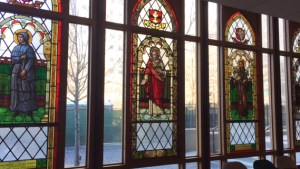Lenten Campaign 2025
This content is free of charge, as are all our articles.
Support us with a donation that is tax-deductible and enable us to continue to reach millions of readers.
One might wonder what a Greek Orthodox church is doing in the midst of a very busy downtown Manhattan, with towering skyscrapers and ongoing construction.
To answer that, we have to look back to the early 20th century, when many Greek immigrants settled in New York. The original St. Nicholas Greek Orthodox Church was founded in 1916 in a small row house that had been used as a tavern. Greek immigrants purchased it in 1892 as a community home. For many Greeks coming to America, it would have been among their first stops after being processed at the immigration center on Ellis Island.
So, like many old churches in New York, the city grew up around St. Nicholas, and in the 1960s, a particularly well-known aspect of that growth changed the parish’s history forever.
“The little church stood in exactly the same location, 155 Cedar Street, witnessing the decades of growth and transformation around the financial centers of Wall Street and Battery Park,” says St. Nicholas’ website. “Even through the 16-acre construction of the original World Trade Center in the 1960s, the little church was an ever-present spiritual jewel, open to all. There are generations of New Yorkers who remember stopping by to light a candle, say a prayer, or just sit quietly. Over the years, the community of Saint Nicholas resisted attempts to sell the property, and by 2001, the church was encircled by a parking lot.”
On the morning of September 11 of that year, everything changed. The little “jewel box” of a church, as some regarded it, was completely destroyed in the collapse of World Trade Center Tower 2 during the terrorist attack. No one was in the church when it was destroyed, but, the church says, “there are reports of Greek Orthodox Christians who escaped the burning towers by running toward the sacred sound of the bell in the campanile that was a visual hallmark” of St. Nicholas.
During the recovery operation that lasted for months after the attack, only a few precious relics of the church were found. Incredibly, in 2010, remains of an 18th century ship were unearthed on the very location of the former church.
“The Miracle-working Saint is known throughout the world as the patron saint of those who sail the sea, and many took this as a sign that the resurrection of the church was nigh,” the website says.
Now, 10 years later — as we approach the 20th anniversary of the 9/11 attack — the new St. Nicholas — formally called St. Nicholas Greek Orthodox Church and National Shrine — is taking form. Though it is not expected to be completed this year, there are plans to “unveil” the exterior by September 11, and to light the church at dusk the evening before.
Less than a month later, Ecumenical Patriarch Bartholomew of Constantinople – “first among equals” of all the Orthodox patriarchs – will visit the church. Bartholomew is scheduled to officiate at the door-opening ceremony on November 2.
The design of the structure will certainly be familiar to the Ecumenical Patriarch — and would have been familiar to the thousands of Greeks who came here over the past centuries. Located at 130 Liberty Street, adjacent to the 9/11 Memorial, it bears a resemblance to the Hagia Sophia of Constantinople, once the “mother church” of Byzantine Christians.
“It will be for our Orthodox community, our American Parthenon and our American St. Sophia,” Michael Psaros, vice-chairman of Friends of Saint Nicholas, a non-profit raising funds for the project, told Crux.
Psaros said that the second floor of the shrine will have a non-denominational ecumenical bereavement center open to the public to “say a prayer, light a candle, or pay their respects however their religion feels appropriate,” Crux reported.
“St. Nicholas Shrine is a cenotaph to the 3,000 people that were murdered, martyred and killed” on 9/11, Psaros said. “At ground zero today you have the museums, you have the reflecting pools, but now you have faith. You have this magnificent structure whose doors will be open to people of all faiths around the world.”
The church should be completed in March or April of 2022.



